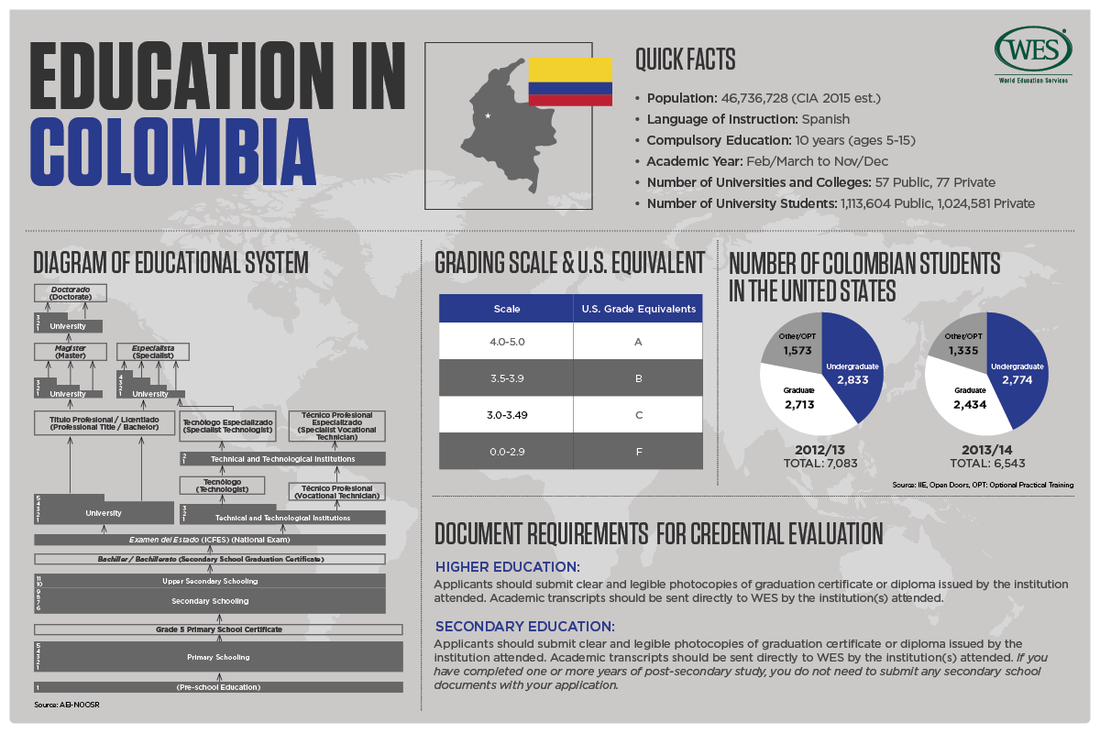Striving towards equality and efficiency Source: http://wenr.wes.org/2015/12/education-in-colombia Source: http://wenr.wes.org/2015/12/education-in-colombia By: Nathalie Jaramillo Colombia has an eleven-year education system with both primary and a secondary school. Primary school consists of five years and begins at the age of six. Secondary school is divided into four years of basic secondary education and two years of upper secondary education. During upper secondary education, many different "tracks" are offered, which all lead to their own "Bachiller" after a curriculum of two years. These technical tracks include an industrial track, a commercial track, a pedagogical track, an agricultural track, and a social promotion track. The basic education cycle in Colombia is free and obligatory for all children between the ages of 5 and 15. According to wenr.wes.org, public universities usually cost around $1,000 per semester. Private universities typically charge between a range of $1,000-5,500 per semester. Investing in education now can define the future of Colombia’s youth. Children Beyond Our Borders, Inc. (CBOB) has one program where you can sponsor a student at the university level. Our IAMCBOB Program has sponsored 5 students in Colombia to receive their graduate degree, one has graduated and 4 are less than a year away from doing so. Our scholars are chosen by a rigorous application program and stay in the program fulfilling requirements that mean staying academically on top, doing community service and being involved, even from afar with the members of the CBOB community. According to worldbank.org, young people represent almost 30% of the working age population and around 17% are unemployed due to lack of training and skills necessary for employment. In 2010, only 37% of secondary school students continued on with their education to the university level. The government has set a goal of increasing to 50% of students enrolling at a university. Colombia has also set the goal of becoming “the most educated” country in Latin America by 2025. This can only be accomplished by improvements in the quality and equity of education. One step that has brought Colombia forward is the national bilingual program that requires English to be taught during primary and secondary school. This gives Colombian students the advantage of having desirable skills in the labor force. Education is regulated by the Ministry of Education and 10% of the government’s budget must be spent on education. The Ministry of Education outlines the learning objectives and subject areas for each grade level, but schools are allowed to organize their own specific study plans to meet the needs of their community. The World Bank is collaborating with Colombia in the education sector to allocate funds and resources towards projects that will help further the growth of academic achievement. With the increasing development of the education system, Colombia is on the path to building a better foundation for their youth. We invite you to learn more about this program and how you can become a sponsor. We have many students waiting for a sponsor and for $75 a month/$150 a month you can give them the chance at an education and the title of being an IAMCBOB Scholar. Visit http://www.chbob.org/iamcbob-scholarship for more information. Sources:
0 Comments
Leave a Reply. |
Archives
July 2021
|
|
Follow Us |

 RSS Feed
RSS Feed